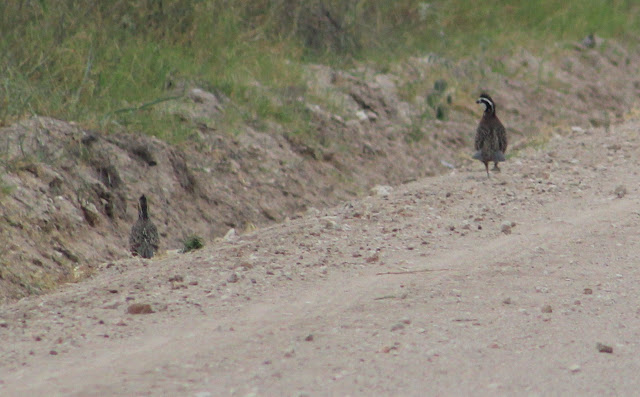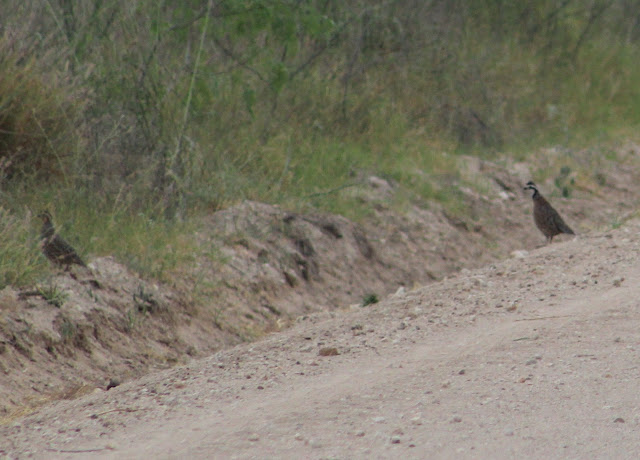After South Padre Island, we were still close to the eastern side of the Rio Grande Valley. And after South Padre Island, we still had one more adventure we wanted to attempt in the Rio Grande Valley...
The Rio Grande Valley is one birders can't get enough of, especially in the sections of three full days that we birded in and around it. It's a place that I would love to spend a week or more in and to simply take my time while slowly birding all of the Valley. There is much to see and much to discover at all times of the year. This last expedition was on the shorter side, and it took us into the grounds of the Lower Rio Grande Valley National Wildlife Refuge. True to the other locations in the Valley we had visited, this area hosts the usual bird suspects and a plethora of exploring that can be done. It is also known to be home to the endangered Ocelot, the small wildcat that is a ghost to most visitors in the region. In the short time that we had, we were after Ferruginous Pygmy-Owls.
Ferruginous Pygmy-Owl is arguably the most wanted and toughest owl to get in the United States. It has the smallest range of any owl in the family, and it has to talk in order for birders to land it. I've had my fair share of Ferruginous Pygmy-Owls in Arizona and so has Caleb. David had seen the owl in Arizona on a trip he took and Liam had them previously in Texas. For Josh, it would be a highly wanted lifer, and we made a point to make an attempt for it. During the trip, we were also closing in on 300 species for Texas, and we all wanted to have a Texas Ferruginous Pygmy on there too!
David, Josh, and I took one car to a location on the Refuge to look for owls and Caleb and Liam took another one. The day had become overcast and I thought that could boost our chances for the owl. At one point, Josh mis-read the directions for one spot that we were going to visit. We had to forget about the spot because we had already driven too far out of the way to go back, and it left us with one other spot that we were supposed to check. Liam and Caleb were searching a spot about forty minutes away from our spot. Josh had David go onto a dirt road, where we stopped at a spot that was said to be good for our target. We saw a few birds walking across the road, and I was thrilled that we chose this spot because these birds were my first ever real views of two Northern Bobwhite.
In eastern North America across farmlands, fields, brushy habitats, and grasslands, the call "Bob-Wheeiiit!" is a common sound. The second note of the call is much higher pitched and exclaimed than the first note, and it is clear that this is where this quail gets it's name from.
Northern Bobwhites are secretive birds, but their common numbers give birders good chances for observations. They travel together in flocks or "coveys" and try to find as much cover as possible. These coveys may have numbers that go from anywhere from three to fifteen birds, and they roost on the ground at night in groups that sometimes number thirty. The Bobwhite feeds mostly on seeds and leaves, as well as insects.
There are several subspecies of Northern Bobwhite in North America, including the endangered and southwestern race known as "Masked Bobwhite", which is being re-introduced into southeastern Arizona. For the common Bobwhites of the east, they are an important species to have habitat managed for and they are also a very popular game bird.
While pursuing the Bobwhites further, I lost track of them as they blended into their environment perfectly at a close range. I didn't realize how close I was until they flushed. At that time, I thought I heard a few "toot" calls that sounded like a Ferruginous Pygmy-Owl. They were immediately followed by a selection of notes from a Northern Mockingbird. The same thing happened again, and again. I was confused, and thought the owl-like notes had to have been coming from the Mockingbird. I looked down the road and it didn't seem to have caught David and Josh's attention.
As I continued to listen, I heard the owl-like notes again and this time a Mockingbird didn't immediately follow the notes. Just like that I knew we had a Ferruginous Pygmy-Owl and I keyed David and Josh into the calls. We walked up the road towards the calls, and luckily, it was an active owl who was delivering notes on a regular basis. On another lucky note, the calls were coming close to the road when the property of the Wildlife Refuge was a barbwire fenced-off on both sides and it would've been interesting to slide under the fence (and trespass). This owl was awesome, and didn't give us too much trouble.
The FEPO switched perches a few times, but for the most part it stayed put and was cooperative for us right along the road.
Those of you who know me well know that owls are my favorite family of birds. Ferruginous Pygmy-Owl is one that I'll want to see anytime, and this was only the fifth sighting that I've had of the species. I also love to see people get owls as life birds. As I said earlier, this was Josh's first ever FEPO!
The Cactus Ferruginous Pygmy-Owl, subspecies cactorum, is the subspecies that is found in Arizona. It is paler than the Texas subspecies of FEPO, which is called ridgwayi. The Texas subspecies of the owl is more rufous and brighter than the Arizona subspecies, and this Texas bird gave me some of the best views I've had.
Here is a picture of what the general Ferruginous Pygmy-Owl habitat looks like in the Rio Grande Valley.
Meanwhile, as Josh, David, and I were enjoying the heck out of an owl, Liam and Caleb were at a spot that was said to be much better for the bird than the one we were at. When we checked in on them to see how they were doing, they weren't having any luck. The overcast conditions that were common on our trip was something I wasn't fond of, but in this case, I think it may have contributed to the owl calling in the middle of the afternoon. Show us both sets of eyes, Mr. FEPO..
Pygmy-Owls are small owls that are fierce and will prey on birds that are larger than themselves. Due to their diurnal nature, they would also be prey for other owls and raptors. The Creator gave them false "eyes" on the back of their head to ensure their survival. When a predator sees a Pygmy-Owl, most of the time it will consider the chase a lost cause because it thinks the owl is already looking in their direction and will likely escape. Because of those false "eye spots", Pygmy-Owls remain as a heavy force in Mother Nature's balance.
The word "Ferruginous" means rusty in coloration, and it's where this small owl gets it's obvious name from. Because I'm obsessed with owls, here's a series of closing photographs to close out this FEPO observation.
With a productive smaller adventure going down as a success for our trio, it was a great to succeed on Ferruginous Pygmy-Owl like we did. This bird was brighter than the ones I have seen in Arizona, and I have to say I liked it better than the Arizona birds. We were about to head off and go further northeast along the Gulf Coast in Texas, and leave the Rio Grande Valley for the final time on the trip. Every location we visited and birded within this Valley was spectacular, and I know that I want to go back again in the years that are soon to come. I said bye to the Rio Grande Valley for the time being and when a Green Jay popped up as we were leaving, it was the perfect way to say, "till next time".
































No comments:
Post a Comment